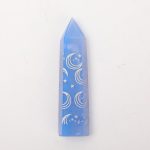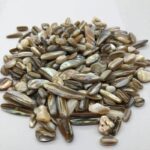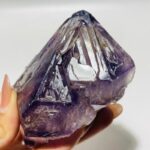Introduction
Calcite, the versatile mineral known for its diverse forms, colors, and properties, has captivated and intrigued scholars, scientists, and artists for centuries. From its mesmerizing optical effects to its practical applications, calcite stands as a testament to nature’s boundless ingenuity.

The Nature of Calcite
Composition and Structure
Calcite is a carbonate mineral composed primarily of calcium carbonate (CaCO3). Its crystalline structure exhibits a trigonal symmetry, resulting in a rhombic cleavage pattern that characterizes its blocky, geometric form.
Colors and Varieties
Calcite boasts a wide array of colors, including white, clear, yellow, pink, orange, and green. Its transparency can vary from transparent to translucent to opaque, depending on its composition and impurities. Notable varieties include Iceland spar, a transparent form used in optics, and onyx, a banded variety often employed in decorative applications.
Optical Properties
Calcite possesses unique optical properties that have been harnessed for various applications. Its birefringence, the ability to split a single ray of light into two, makes calcite an essential component in polarizing filters and optical instruments. Double refraction, another characteristic, has been exploited in Iceland spar to create calcite crystals with astonishingly clear and aberration-free images.
Industrial Applications of Calcite
Cement and Building Materials
Calcite is a primary ingredient in the production of cement, a vital component of concrete. Its role as a flux enhances the cement’s strength and durability. Calcite is also used as an aggregate in construction, providing a stable and cost-effective base material.
Soil Amendment
In agriculture, calcite serves as a soil amendment to neutralize acidic soils and provide calcium for plant growth. Its calcium content promotes root development and enhances overall soil health.
Paper Industry
Calcite is employed in the paper industry as a coating agent, imparting a smooth and glossy surface to paper products. It also enhances the brightness and opacity of paper, improving its quality and printability.
Pharmaceuticals and Cosmetics
Calcite finds its way into various pharmaceutical and cosmetic applications. Ground calcite is used as a filler or carrier in tablets, capsules, and powders. Its anti-acidic properties have also been harnessed in over-the-counter medications for heartburn and indigestion. In cosmetics, calcite powder adds a subtle shimmer and luminosity to products like eye shadows and mascaras.
Artistic and Decorative Uses
Jewelry and Ornaments
Calcite’s vibrant colors and unique formations make it a popular choice for jewelry and decorative ornaments. Gem-quality calcite, known as Iceland spar, is faceted into stunning gemstones, while other varieties are carved into intricate figurines and amulets.
Sculptures and Architectural Elements
Calcite’s malleability and durability have inspired its use in sculptures and architectural elements. Its ability to take on complex shapes has resulted in captivating statues, fountains, and decorative features that enhance both indoor and outdoor spaces.
Lighting and Optics
Calcite’s ability to transmit and manipulate light has found its way into lighting and optical applications. Iceland spar crystals have been utilized in high-end optical devices, while calcite prisms and filters are used to create mesmerizing lighting effects in chandeliers, lamps, and stage lighting.
Healing and Metaphysical Properties
Energy and Vibrations
Calcite is believed to possess a calm and tranquil energy that promotes emotional balance and stability. It is said to enhance creativity, imagination, and spiritual awareness. Its high vibrational frequency is thought to resonate with the higher chakras, opening up channels for spiritual connection.
Physical Healing
In traditional healing practices, calcite is often used for its purported physical benefits. It is believed to aid in bone health, reduce muscle tension, and soothe inflammation. Some also claim that calcite can support the immune system and improve overall energy levels.
Metaphysical Uses
Calcite is a popular stone in metaphysical circles, where it is believed to enhance psychic abilities, promote lucid dreaming, and protect against negative energies. Its various colors are said to correspond to different energy centers, allowing for targeted healing and spiritual growth.
Calcite Stones: Comparative Analysis
Table 1: Calcite Varieties and Colors
| Variety | Color | Notable Features |
|---|---|---|
| Iceland spar | Transparent | Extraordinary optical properties |
| Onyx | Banded | Distinctive alternating layers |
| Blue calcite | Blue | Calming and soothing vibrations |
| Green calcite | Green | Associated with heart chakra healing |
| Pink calcite | Pink | Enhances emotional well-being |
Table 2: Calcite Applications and Industries
| Application | Industry | Benefits |
|---|---|---|
| Cement production | Construction | Strength and durability |
| Soil amendment | Agriculture | Neutralizes acidic soils, enhances plant growth |
| Paper coating | Paper industry | Smoothness, brightness, opacity |
| Filler and carrier | Pharmaceuticals, cosmetics | Improves tablet quality, adds shimmer |
| Jewelry and ornaments | Arts and crafts | Unique colors, intricate formations |
Table 3: Healing Properties of Calcite
| Property | Benefits | Associated Chakras |
|---|---|---|
| Emotional balance | Calms stress, promotes serenity | Root chakra |
| Creativity enhancement | Boosts imagination, opens up new ideas | Sacral chakra |
| Spiritual connection | Facilitates higher vibrational frequencies | Crown chakra |
| Bone health support | Strengthens bones, reduces muscle tension | Root chakra |
| Immune system support | Enhances overall vitality | Root chakra, Solar plexus chakra |
Table 4: Pros and Cons of Calcite Stones
| Pros | Cons |
|---|---|
| Versatile with diverse applications | Can be brittle and easily scratched |
| Aesthetically pleasing with vibrant colors | May fade over time with exposure to sunlight |
| Durable and long-lasting | Can be difficult to find in large, high-quality pieces |
| Relatively affordable | Not as valuable as some other gemstones |
FAQs on Calcite Stones
1. What is the difference between calcite and marble?
Calcite is a mineral, while marble is a metamorphic rock primarily composed of calcite. Marble forms when calcite undergoes heat and pressure, resulting in a recrystallized and often banded appearance.
2. Is calcite safe to use in jewelry?
Yes, calcite is generally safe to use in jewelry. However, due to its softness, it is recommended to handle calcite jewelry with care to avoid scratches and breakage.
3. How can I cleanse my calcite stones?
Calcite can be cleansed by running it under warm water or by placing it in sunlight for several hours. Avoid using harsh chemicals or ultrasonic cleaners, as these may damage the stone.
4. What is calcite’s Mohs hardness?
Calcite has a Mohs hardness of 3, indicating that it is a relatively soft mineral. This means that it can be scratched by harder objects, such as steel or quartz.
5. Is calcite a piezoelectric mineral?
Yes, calcite is a piezoelectric mineral, which means it can generate an electrical charge when pressure is applied to it. This property makes calcite useful in certain electronic applications.
6. What are the potential hazards of calcite exposure?
Calcite is generally considered non-toxic, but it may release calcium dust when crushed or pulverized. Inhaling this dust can cause respiratory irritation, so proper precautions should be taken when working with calcite in its powdered form.
7. How is calcite formed?
Calcite is primarily formed through the accumulation of calcium carbonate in various environments, such as marine settings or caves. It can also form through the precipitation of calcium carbonate from water.
8. What is the “calcite cloud”?
The “calcite cloud” refers to the apparent cloudiness or haziness that can be observed in certain Iceland spar crystals. This phenomenon is caused by the presence of tiny bubbles or inclusions within the crystal, which scatter light and give it a milky appearance.




























